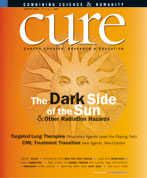Genetic Interactions
Cancer develops because of permanent changes in a person's genes. Environmental factors, including various types of radiation exposure, are responsible for gene alterations that scientists are just beginning to understand.
Exposure to a carcinogen (cancer-causing substance) doesn’t mean a person will get cancer. It’s a complex collaboration between how long, how much and how often a person is exposed to a carcinogen as well as the person’s age, diet and other lifestyle factors.
“Ultimately, there are few things that can put an entire population at risk, and ionizing radiation is one of them,” says Raymond Tennant, PhD, director of the National Center for Toxicogenomics. “We know that almost regardless of your genotype, exposure to high-dose rates of ionizing radiation carries with it a high probability of inducing tumors.”
Ionizing radiation contains enough energy to remove tightly bound electrons from atoms, and, in the case of extremely high-energy radiation, break up the nucleus of atoms. Therefore, ionizing radiation is used in radiation therapy for cancer because of its ability to damage the genetic material of cancer cells. (Radiation therapy also damages healthy cells, most of which recover and function properly.)
Dr. Tennant says in cases not including radiation exposure, genetics determine the probability an individual will develop cancer. Researchers have identified a recessive gene called ataxia telangiectasia mutated (ATM) that may be involved in a variety of cancers. The ATM gene controls cell division, and more than two million Americans carry at least one copy of the altered gene.
Inherited syndromes associated with significant sensitivity to UV and ionizing radiation include ataxia telangiectasia (A-T) and xeroderma pigmentosum (XP). These disorders result from abnormalities in genes required for repair of DNA damage from environmental radiation exposure.
A-T is a rare disorder (seen in one in 40,000 births) caused by mutations in the ATM gene. Children with this syndrome lack muscle control (ataxia) and have irregular blood vessels under their skin (telangiectasia). The first symptoms usually appear by age 2, and cancer (typically leukemia or lymphoma) develops in about 20 percent of those with A-T. The frequency of carriers is much higher than the number of full-syndrome patients. Though carriers have only one mutated copy of the ATM gene, and are thus asymptomatic, they are still sensitive to radiation-induced cancers.
XP, another uncommon disease, results from a defect in a series of enzymes involved in DNA repair. Affecting one in 250,000 Americans, XP patients younger than 20 have a 1,000-fold increase in the incidence of skin cancer and melanoma and should be protected from low-level light and sun exposure.
The EPA already regulates radiation exposure at fairly low levels, but “the kind of science we’re looking at could give us a handle on identifying who in the population might be more at risk from ionizing radiation exposure,” says Michael Boyd.
Michael Thun, MD, says a futuristic example often presented involves people having a card that tells them the diseases they’re genetically susceptible to, with the expectation that they will modify behavior to prevent them. “That’s kind of simplistic because many of the factors, like smoking, physical inactivity and obesity, affect many diseases,” says Dr. Thun, chief epidemiologist at the American Cancer Society.
But the earliest benefit would be to tailor treatment, he says. “The most progress in understanding genetics has been for single-trait diseases (like A-T and XP). But for most of the common diseases—heart disease and cancer—it’s likely they are affected by multiple genes. And understanding that is a substantial challenge.”
Dr. Tennant feels significant treatment progress has been made over the past 40 years. But he points out that the major therapies doctors depend on are killing therapies targeted to kill rapidly proliferating cells.
“It’s only now that we’re beginning to develop intervention strategies that are based on understanding how tumors arise,” says Dr. Tennant. “Application of genomic technologies will hasten our ability to understand the processes that give rise to cancer and the interaction between the environment and the genotype.”
